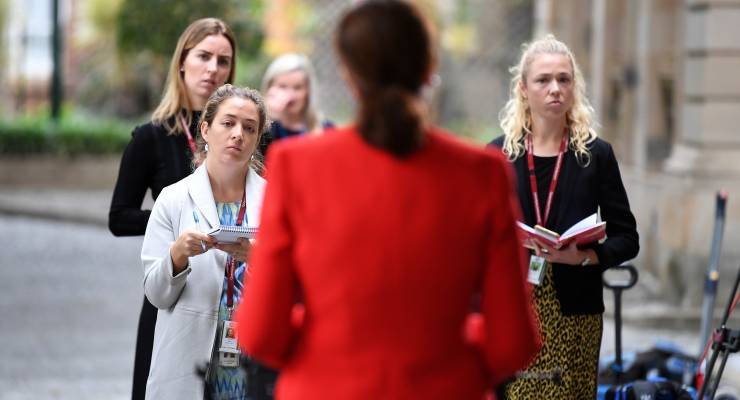
Australia’s media landscape is facing a tremendous loss as one in three women in the industry contemplate quitting their jobs.
More than half of women in the media game are either unsure about or dissatisfied with their career progress. Almost one in three are thinking about leaving their roles in the next 12 months, the Women in Media group’s 2023 industry insights report shows.
The sector has reached a critical moment with mid-career women particularly inclined to quit, Women in Media strategic adviser Petra Buchanan said. Almost half of women who have been in the media for between five and 10 years are weighing up whether to leave their roles in the next year.
The loss to the country’s media landscape would be tremendous if the industry did not urgently change and women walked out, Buchanan said.
“Women are 50% of the population and we need to ensure that their voices are bringing both stories forward [and] a perspective that’s inclusive and representative of the Australian population,” she told AAP. “That departure would be a real loss to society, more broadly.”
Women surveyed for the report flagged lacking opportunities, pay and engagement as the main factors driving them to quit.
Australian women across all industries make on average $255.30 a week less than men, which is the equivalent of a 13.5% pay gap, according to the Australian Bureau of Statistics. The weekly earnings gap rises to 16% for women in the information, media and communications industry.
Gender pay audits are rare, yet 85% of women in media want them to address the entrenched pay disparity, Buchanan said. More than 60% of women in the industry want shadowing programs, an increase of about 20% compared with last year.
If the industry failed to address its issues, there would be fewer women in top jobs leading gender inequality to persist for future generations, Buchanan suggested.
“If we have people in the middle stages of their career leaving, they’re the ones that are not going to be progressing,” she said. “All we’re going to be doing is filling the bottom up more and having people leave in the middle.
“We know that many studies around the world show that having women in senior leadership positions makes for better-run organisations that are more inclusive and ensure equity at various levels.”
More than half of women rate the media industry’s commitment to gender equality as weak or very weak, and more than 10% point to bias and discrimination as the reason behind their careers stagnating.
Women cited limited access to training and development and a lack of both managerial support and opportunities as the top reasons why their careers had not progressed.
Women in Media called on the industry to commit to actively addressing gender equality, improve pathways to promotion and support for women, and increase women’s access to upskilling opportunities.
More than 260 women were surveyed for the report by Women in Media, which will hold its annual national conference in Sydney in September.








How can women work and serve honestly and openly in media run by Murdoch, Stokes, Costello? Horrible prospects there.
Even the “seasoned” women lucky enough to catch the limelight, omit to follow the cruelty and greed ; this gaslights the victims ; women stuck, due to circumstances where casualised domestic slog work run by corporatised charity / nfp’s middle men profiting in aged, childcare are makin the moula- whilst entrenching women ( many still rearing kids – are turned into fodder – then due to theft of our agency we are indentured into this lie of “mutual obligations” – where is our agency is shackled ; like domestic violence , this is another symptom the subtle face of economic abuse – female contributions are assumed then unequally compensated We have to keep nice and maintain the status quo
I believe at least a third of male journalists are alsi thinking about getting out of the industry. Its a mess and the management is brutal to all journos unless they happen to be a very successful right wing shock jock bringing in millions. I accept that in this environment the women are copping it harder than the men which is pretty sad.
What we need are new options built without the toxic stuff thats inbuilt in traditional media.
How does this compare to women in, say, accounting, law, IT or medicine?
And how does it compare with male journalists?
And what were the questions used to elicit this response? And how were the responses categorised?
I only ask because “one in three” doesn’t sound to be a particular problem.
I’ve seen first hand the way the public ‘attack’ female journalists in ways not done to men.
I’ve witnessed a senior female Muslim journalist be attacked because, Muslim and a woman. NOthing wrong with the reporting. I worked with this woman for The Junction/C31 election coverage.
I see regularly – and it only happens to female reporters – “Look at what she’s wearing, that’s dress is horrible. I dont’t like her hair.” Has SFA to do with the actual job at hand though though – reporting.
Then, to use an example, as a journalist myself …
There’s a building fire in Preston last week. I reside in Reservoir.
I turn up to cover the fire. In trackie dacks with cigarette burn holes, an old ‘flouro’ jumper, beanie and I am unshaven and forgot to put my dentures in, in the rush to get to the scene. (Or what one might call a ‘uniform’ in Reservoir).
Not a word was said about my dress, the fact I’m unshaven, in trackie daks. If I was a female reporter, by the time I’d done make-up, hair, wardrobe etc, it’s too bloody late. The story is over and the fire is out and the fire brigade is rolling up the hoses and packing up. Too late.
When Cyclone Tracey happened, Mal Walden went to air from Darwin in stubbie shorts and a t-shirt. The important bit is to get the news broadcast and information to the public. No one cared that Mr Walden wasn’t in a suit and tie. There’s no time for that.
Now, if Mr Walden was a female reporter, there’d still be comments today about “did you see that silly dress/skirt/top she was wearing” that reporter was wearing.
I feel for my female peers. And even more so female peers who aren’t white. They have to work twice as hard as us blokes to achieve the same. FACT. The ‘non white’ one’s even harder again. And boy do they cop it.
But me, in full Rezza uniform, with my front teeth missing, unshaven, and not a word is said. Funny that. Why, what’s more important? The top I’m wearing or the news I’m trying to convey?
If WWIII broke out today and Australia was bombed this afternoon and a female reporter was ‘first on scene’ the first thing we’d hear about is the dress she is wearing, or how she went to air ‘without make up.’ not the outbreak of WWIII.
Sometimes, such as wars, emergencies, fires and other circumstances, journalism is like being a firefighter or ambulance officer. “It’s go time. There isn’t time to sit in a make up chair for an hour or two getting dolled up to ‘go to air.’
Would you prefer a female journalist, in urgency circumstances, is more concerned about her appearance and ‘make -up’ (knowing the pile on coming) rather than get on scene, to you know report.
IN an urgent situation, forget a hairbrush. You need ya pen, A5 pad and a dictaphone. Who cares what the dress looks like? Sadly, too many in the public can’t see forest for trees.
Sure. If I had more time I would have at least put on slacks and a blazer. It’s a Iive, going fire. Forget getting changed, just get on scene and report. I mean, heck, that’s like saying, sorry Captain I have to comb my hair when the alarm bell rings in CFA fire station. Forget your hair, get ya gear on, get in the truck and go.
Be critical of the journalism. And only the journalism.
Heart felt first hand and im not going to critique per above the style – just the substantive content.
That may even the sides in the gender war.